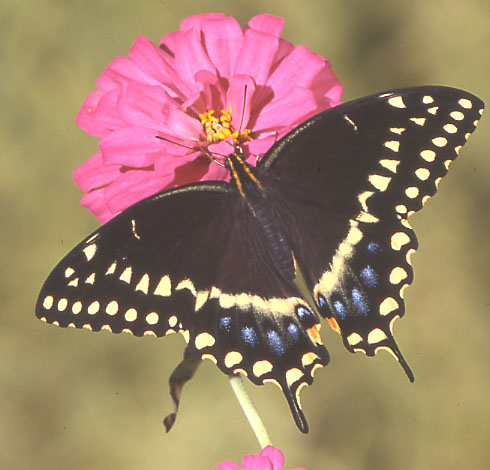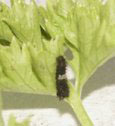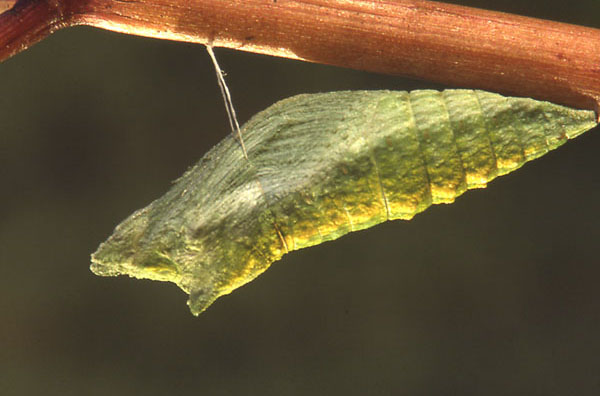Papilio polyxenes asterius
pa-PIL-ee-ohmm
paul-ICKS-en-eesmm
as-TEAR-ee-us
Stoll 1782

Papilio polyxenes asterius, male, courtesy of Leroy Simon.
Superfamily: Papilionoidea Latreille, 1802
Family: Papilionidae, Latreille, 1802
Subfamily: Papilioninae Latreille, 1802
Tribe: Papilionini Latreille, 1802
Genus: Papilio Linnaeus, 1758 |
Website designed and maintained
by Bill Oehlke
Box 476, Montague
Prince Edward Island, Canada C0A 1R0
oehlkew@islandtelecom.com
|
Distribution:
The Black Swallowtail
(wingspan: 3 1/4 - 4 1/4 inches (8 - 11 cm)) flies
in open fields, gardens, marshes, deserts, and along roadsides
throughout most of the eastern United States and Canada westward to
southern Saskatchewan, Colorado and southeastern California
and southward to northern South America.
The subspecies coloro flies in the desert of the Southwest.
Description:
The dorsal wing surfaces are
predominantly black. Along the inner edge of the hindwing is a
black spot centered in a larger orange-yellow spot.
The males have a wider yellow band near the center of the forewings;
the female has a narrower row of yellow spots and an iridescent blue band
on the hindwing.
In the Southwest, yellow forms predominate in
the subspecies Papilio polyxenes coloro.
On the ventral surfaces, the yellow markings are replaced with
deep orange replicas.

Papilio polyxenes asterius, courtesy of Leroy Simon.

Papilio polyxenes asterius, female, courtesy of Leroy Simon.
Flight time(s) and Adult Food Sources:
In Canada and
cooler portions of its range, there are two to three flights from
April-October. In warmer regions
this butterfly broods continuously as conditions permit.
Butterflies feed on nectar from many flowers including red clover,
milkweed, and thistles. I often saw the females ovipositing on
Queen Anne's Lace and then nectaring on flowers of the same plant.
Eggs, Larvae, Pupae:
The larval hosts of dill
(Anethum graveolens),
fennel (Foeniculum vulgare), parsley (Petroselinum sp.),
celery (Apium sp.), carrot (Daucus sp.), Rue,
(Ruta graveolens),
Queen Anne's Lace (Daucus carota), Prairie-parsley
(Polytaenia nuttallii)
and other members of the family Apiaceae result in
frequent adult visitations to the homeowner's garden.
Female butterflies can be observed alighting on soft foliage and
gently curving their abdomens to affix yellow eggs, one per stop, to
the undersides of foliage. In some areas plants in the citrus
family (Rutaceae) are preferred.
Black Swallowtail egg on Flat-leaf Parsley, courtesy of
Dale Clark, Texas. | 
|
 | I am
frequently asked to identify larvae of this commonly
encountered "garden" species. The young larvae are dark brown
with a white saddle and frequently go unnoticed, resting on a mid
leaf vein. They do not even vaguely resemble the form they will
take in approximately two weeks. |
There are several colour and pattern changes as
the larvae moult (shed their skins, making way for new growth),
passing through five instars. People most often
notice the larvae when the caterpillars are almost mature (below)
(approx. 1.5 inches) and have eaten several carrot stems or
dill leaves. Mature larvae are much different from the third
instar forms to the right. |  |

Papilio polyxenes asterius, larva, courtesy of Leroy Simon.
Typical of the Papilionidae, mature larvae fashion a
sling like support of silk to hold them secure during the pupa stage.
Pupae are anchored with a silk pad near the anus and hang either in a
vertical (head up) or horizontal position.
Pupae are usually green with a yellow dorsal cast if they are going to produce
butterflies in two weeks. In the overwintering stage, the pupae are
frequently beige-brown, offering better camouflage against dead,
dried weeds. This is not a hard and fast rule, but a general
indicator of dormancy.

Papilio polyxenes asterius, pupa, courtesy of Leroy Simon.
Larvae are subject to attack from parasitic wasps. For those who want to
watch the complete metamorphosis of this butterfly, the best way to do
so is to observe a female butterfly as she oviposits. Locate a couple
of eggs and bring them into the house, still affixed to foliage, but
first give them a couple of days to incubate and develop outside.
The couple of days outside is to let the eggs harden
and to avoid cut foliage drying out or decomposing before the larvae
emerge. The eggs
and larvae can be reared indoors in a glass jar (quart or liter size
is a good minimum) or plastic tub.
Keep the lid on tight and
DON'T MAKE ANY AIRHOLES in the lid. The caterpillar
will have ample oxygen in the jar or tub. Airholes would allow
the foliage to dry out very quickly, robbing the caterpillar of
much needed moisture.
The rearing container should be cleaned at least every second day and
fresh food should be inserted regularly to replace that which has lost
some moisture.
Mature larvae clear their guts with a lose, runny
stool just prior to pupation.
Commercial breeders usually rear larvae on live, growing food under
protective coverings, sleeves, tents or cages.
The newly formed pupa or chryslid is very soft and should not be
handled. It will harden after a couple of days and can then be moved
to an emergence cage, any sort of enclosure with a vetical surface
(cloth, screen, paper towel, brown paper), that will allow the emerged
butterfly to climb, hang and inflate its wings.
Summer, non-diapausing pupae, usually emerge within fourteen days of
pupation.
Livestock of this beautiful species is usually available from
Bill Oehlke at
oehlkew@islandtelecom.com in the fall as overwintering
pupae.
Use your browser "Back" button to return to previous page.
Visit other websites maintained by Bill Oehlke:
+++LIVESTOCK AND SUPPLIES FOR SALE***
This site is designed and
maintained
by Bill Oehlke. You can reach Bill for questions
by clicking on his name (email) or by phone 902-838-3455,
or at Bill Oehlke,
Box 476, Montague, P.E.I., Canada C0A 1R0.
I offer two membership sites that far exceed the
coverage offered
on the sites listed above:
THE WORLD'S LARGEST SATURNIIDAE SITE and
CATERPILLARS TOO!







